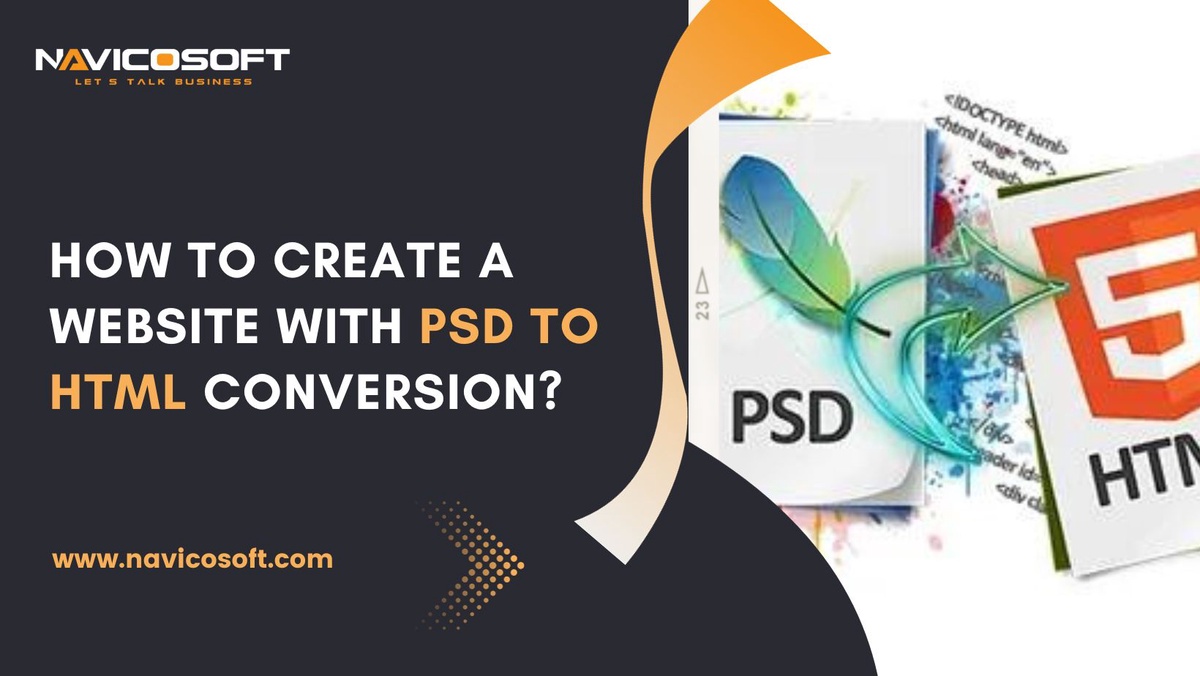A visually appealing and high-performing website is important for businesses and individuals in the fast-paced digital world.
Being around for several years, PSD to HTML is still one of the best ways to get a website.
Thus, one of the crucial steps in creating an effective website is converting a Photoshop Design (PSD) file into Hypertext Markup Language (HTML).
Additionally, this process, known as PSD to HTML conversion, can significantly impact your website's performance, speed, and overall user experience.
This extensive guide will delve into the procedure of a website with PSD to HTML conversion.
Why is PSD to HTML Conversion Important?
Improved Website Performance:
PSD to HTML conversion helps streamline your website's code, making it more efficient and lightweight.
In addition, this optimization leads to faster loading times, reducing bounce rates and keeping visitors engaged.
Enhanced SEO:
Search engines favor well-structured, semantic HTML code. By converting your PSD designs into clean HTML.
It improves your website's chances of ranking higher in search engine results pages (SERPs).
Cross-Browser Compatibility:
Cross-browser compatibility is a crucial metric every website needs to meet. It simply means ensuring your website seems and functions consistently across different browsers and devices.
Additionally, this is crucial for providing a seamless user experience to your audience. However, to make such a website, it is better to let the best PSD to HTML Services provider build it.
Responsive Design:
With the enhanced use of mobile devices, having a responsive website is non-negotiable.
A proper PSD to HTML conversion allows for implementing responsive design principles.
It makes your site adapt to various screen sizes. The more responsive a website is, the more it can cater to unique audiences and visitors' preferences.
Better Accessibility:
Accessibility is a vital aspect of web design. The website with PSD to HTML conversion allows you to incorporate accessibility features, ensuring that your site is usable by individuals with disabilities.
A step-by-step guide for a website with PSD to HTML conversion
Organize Your PSD Files:
Properly organizing your PSD files is the foundation of a successful website with PSD to HTML conversion.
So, begin by grouping and naming layers logically within your Photoshop design.
Merge unnecessary layers to simplify the design structure. Furthermore, this organization not only streamlines the conversion process but also makes it easier to locate and manipulate design elements during coding, ensuring a smoother workflow from start to finish.
Slice Your PSD:
Using the slicing tool in Photoshop, break down your design into individual components, such as headers, footers, navigation menus, and content sections.
Moreover, slicing your PSD design into distinct elements facilitates their conversion into HTML components.
Each sliced component can be coded separately. It allows for more precise control and customization during the conversion process.
Choose the Right Conversion Method:
The conversion method significantly influences the outcome of your websites. Depending on your expertise and project requirements, you can opt for manual coding, online conversion tools, or hiring a professional PSD to HTML services provider. Therefore, manual coding offers the highest level of control and customization but may require more time and technical proficiency.
Write Clean HTML and CSS code:
Regardless of the chosen conversion method, the quality of your HTML and CSS code is paramount. Moreover, ensure that your code is clean, follows semantic structure, and adheres to best practices for coding standards.
Leveraging HTML5 and CSS3 features is essential for creating modern and responsive websites, enhancing your site's functionality and aesthetic appeal.
Optimize Images:
Optimizing images is crucial to reduce page load times and enhance overall website performance. Moreover, use image compression techniques to minimize file sizes while maintaining quality.
Select appropriate image formats (JPEG, PNG, or SVG) and specify image dimensions to prevent unnecessary resizing by web browsers, further enhancing loading speed.
Implement SEO Best Practices:
Enhance your website's search engine visibility. You should implement SEO best practices during the PSD to HTML conversion process.
Incorporate relevant meta tags, include descriptive alt attributes for images, and utilize structured data to improve your site's search engine ranking.
Moreover, adequately structured heading tags (H1, H2, H3, etc.) contribute to content organization and readability.
Test Cross-Browser Compatibility:
Thoroughly test your website on various web browsers (Chrome, Firefox, Safari, Edge, etc.) and devices (desktop, tablet, mobile).
It is to ensure consistent functionality and appearance across different platforms.
Moreover, you should identify and address compatibility issues early to provide a seamless user experience for all visitors.
Ensure Responsiveness:
Verify your website's responsiveness by resizing your browser window or using responsive testing tools.
Moreover, make necessary adjustments to ensure content adapts gracefully to varying screen sizes.
Responsive design is essential for accommodating the diverse range of devices used to access your site.
Validate Code:
Utilize HTML and CSS validators to check for errors and ensure compliance with web standards.
Address any issues detected during validation, as clean and error-free code not only improves performance.
However, it also reduces the likelihood of rendering problems across browsers and devices.
Optimize for Speed:
Improve page loading speed by implementing optimization techniques. It includes modification of CSS and JavaScript, browser caching, and content delivery networks (CDNs).
These strategies enhance user experience and are essential for websites with PSD to HTML conversion. It reduces waiting times and ensures efficient content delivery.
Test Accessibility:
Conduct thorough accessibility audits to guarantee your website is accessible to all users, compromising those with disabilities.
Moreover, identify and address accessibility issues, ensuring that your site complies with accessibility standards and offers an inclusive experience to everyone.
Monitor and Maintain:
If using the PSD to HTML services, they can regularly monitor your website's performance post-launch and make updates as needed.
Stay informed about current web design trends and technologies. It helps to keep your site optimized and competitive in the ever-evolving digital landscape.
Moreover, consistent maintenance ensures your website meets user expectations and business goals.
Conclusion
Creating and optimizing a website with PSD to HTML conversion is crucial in delivering a high-quality web experience to your audience.
Moreover, following the steps outlined in this comprehensive guide, you can generate a website that looks functional, performs excellently, and ranks well in search engines.
It provides an accessible and seamless user experience across all devices and browsers.
So, remember that web optimization is an ongoing process so stay vigilant and adapt to evolving trends and technologies to monitor your website so it remains at its best.
Original source: https://www.authortalking.com/how-to-create-a-website-with-psd-to-html-conversion/


No comments yet